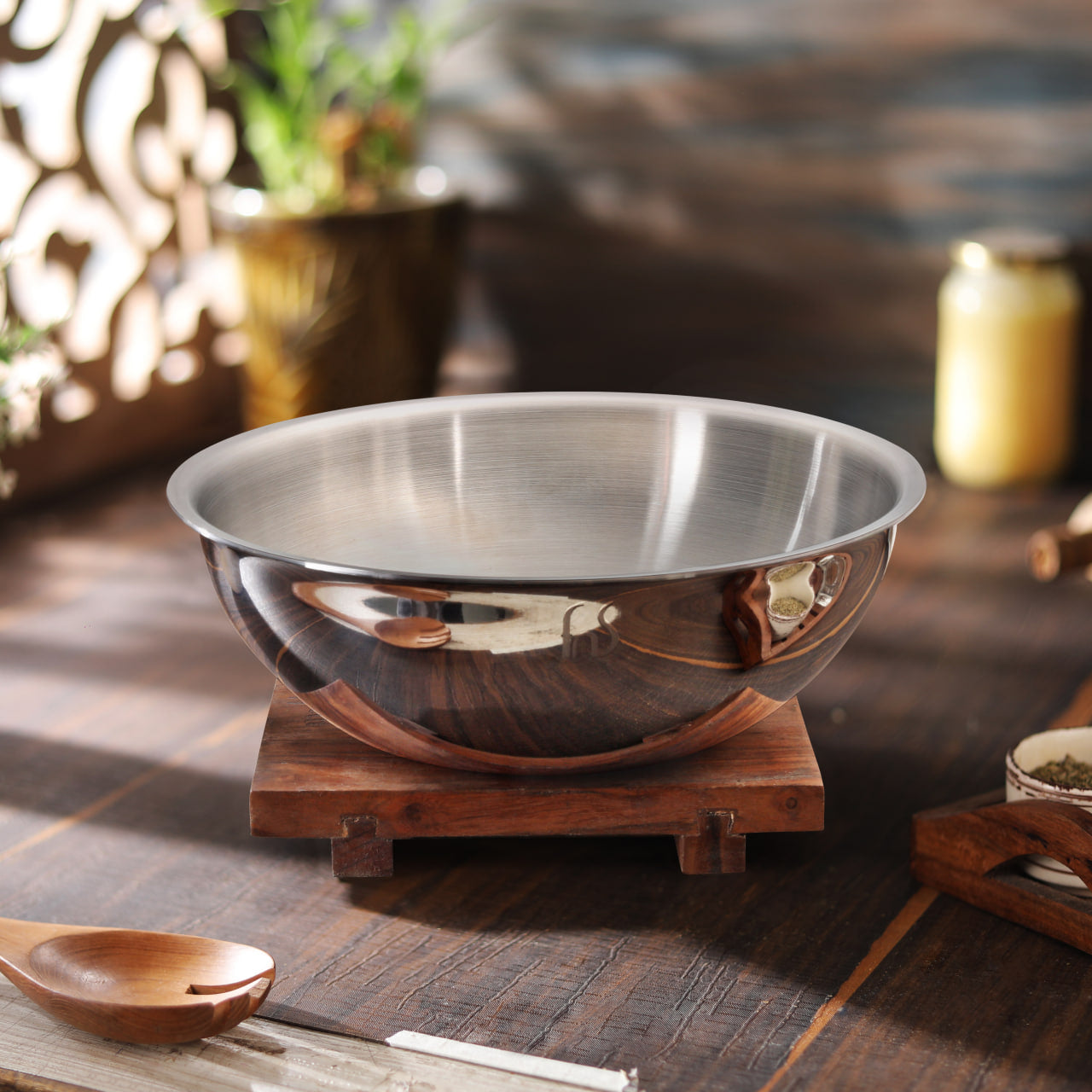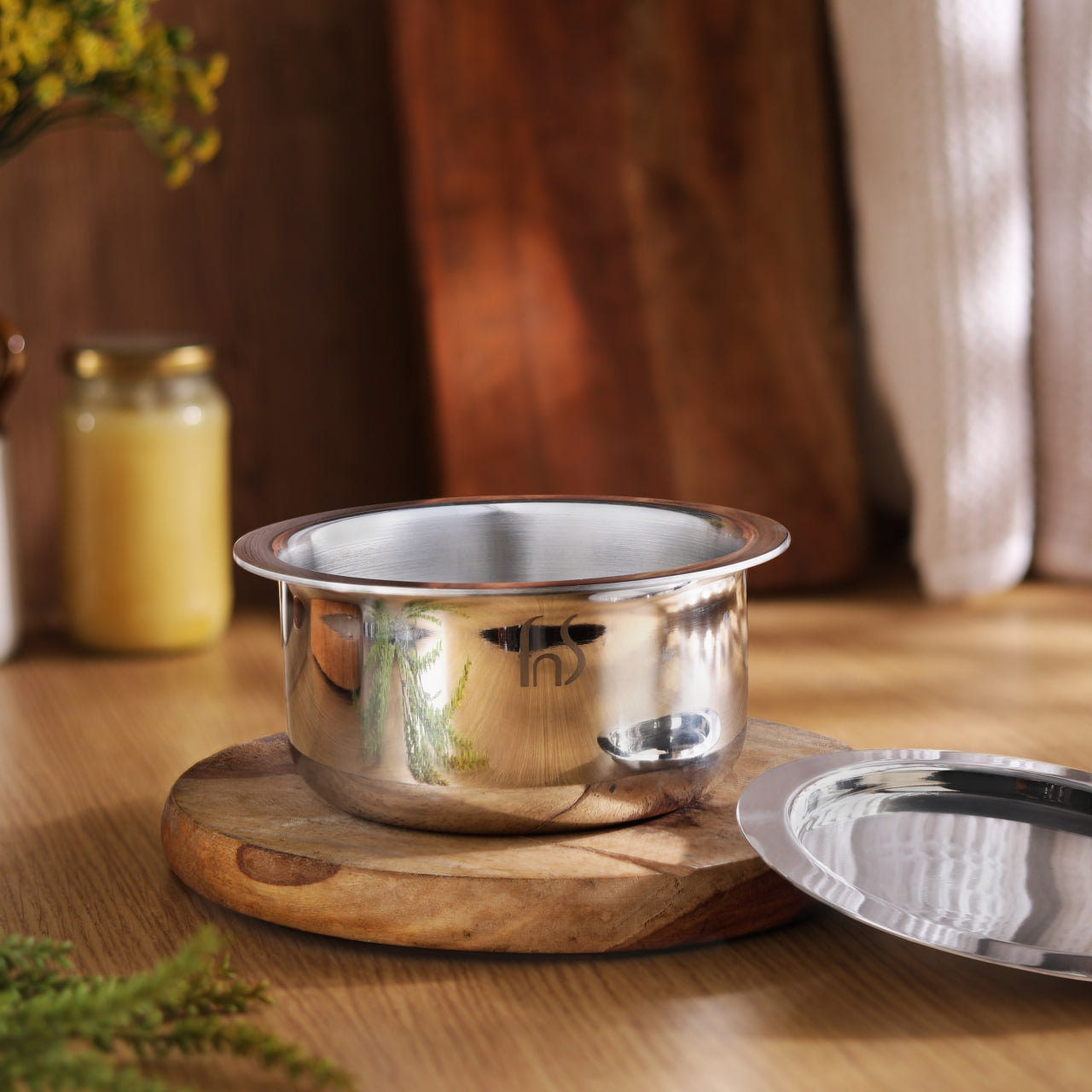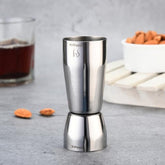Stainless Steel Cookware Buying Guide: How to Choose the Perfect Set for Your Home
Cooking is an art that's even better when you have the right tools. The crackle of mustard seeds, the aroma of spices, and cooking your family's favorite dishes are all made even better when your cookware works with you effortlessly. Stainless steel cookware has been a trusted choice in Indian homes for generations, and for good reason. However, with numerous options available, how do you select the ideal set for your kitchen?
What is Stainless Steel Cookware?
Stainless steel cookware is made of a strong metal that resists rust, stains, and corrosion. Modern stainless steel cookware typically features multiple layers, often including an aluminum or copper core, which promotes even heating and superior cooking performance. These utensils don't react with acidic or spicy ingredients, making them ideal for traditional Indian curries, gravies, and slow-simmered vegetables that require precise temperature control and longer cooking times.
Why Choose Stainless Steel Cookware for Your Kitchen?
Investing in quality stainless steel cookware offers numerous advantages:
-
Long-lasting durability: High-quality vessels don't chip, peel, or rust, lasting decades with proper care and regular use
-
Safe and hygienic: The smooth, non-porous surface prevents bacteria and odors from settling, ensuring food safety for your family
-
Even heat distribution: Multi-layered construction eliminates hot spots that burn food, ensuring uniform cooking results
-
Easy maintenance: Simple to clean with mild soap and warm water—no special coatings or expensive cleaning products needed
-
Professional appearance: The polished finish adds an elegant, refined look to any kitchen setting
-
Environmentally sustainable: Stainless steel is fully recyclable, supporting an eco-conscious household
Key Features of Quality Stainless Steel Cookware
Before making your purchase, evaluate these essential characteristics:
-
High-grade steel quality: Look for food-grade stainless steel that resists rust and withstands daily cooking demands
-
Thick, heavy base: A substantial bottom prevents food from sticking and burning while ensuring uniform heat distribution
-
Tri-ply construction: The combination of stainless steel, aluminum, and stainless steel layers provides superior heat management and longevity
-
Ergonomic handles: Strong, heat-resistant handles with a comfortable grip allow secure lifting and pouring
-
Tight-fitting lids: Essential for covered cooking, heat retention, and pressure cooking applications
-
Stovetop versatility: Ensure compatibility with your gas stove, induction cooktop, or both
Building Your Essential Stainless Steel Cookware Set
A well-rounded cookware collection should include these fundamental pieces:
Stainless Steel Kadhai (20 cm):

Have a Look - https://fns.co.in/products/fns-nuchef-cookware-triply-kadhai-20-cm-with-lid
The backbone of Indian cooking, perfect for deep frying, tempering spices, sautéing vegetables, and slow-cooking curries and sabzis. The curved sides facilitate easy tossing and stirring.
Stainless Steel Fry Pan (20 cm):

Have a Look - https://fns.co.in/products/fns-nuchef-cookware-triply-frypan-20-cm
Versatile for shallow frying, sautéing, and preparing breakfast items. Flared rims allow effortless flipping without spillage, ideal for dosa, omelettes, and paneer preparations.
Stainless Steel Sauce Pan (14 cm):

Have a Look - https://fns.co.in/products/fns-nuchef-cookware-triply-sauce-pan-14-cm-with-lid
Essential for cooking dal, lentils, soups, and gravies. The straight sides allow precise liquid measurements crucial for Indian recipes requiring specific consistency.
Stainless Steel Tasla (20 cm):

Have a Look - https://fns.co.in/products/fns-nuchef-cookware-triply-tasla-20-cm
A traditional shallow vessel perfect for quick stir-fries, toasting whole spices, and preparing lighter dishes with minimal oil, reducing calories without compromising flavor.
Stainless Steel Tope (16 cm):

Have a Look - https://fns.co.in/products/fns-nuchef-cookware-triply-tope-16-cm
A deep cylindrical vessel ideal for cooking rice, boiling water, steaming, and preparing larger batches of food for family gatherings.
Maintenance Tips for Long-Lasting Performance
Your stainless steel investment needs proper care. Hand wash with mild dish soap and warm water using a soft sponge. For stubborn stains, make a paste of baking soda and water. Dry immediately with a soft cloth to maintain the polished look and prevent water spots.
Conclusion: Make the Right Choice for Your Home
Choosing high-quality stainless steel cookware is an investment in your family's everyday cooking experience and culinary legacy. Look for brands that offer premium tri-ply construction, food-grade materials, and proven durability. Choose pieces that fit your actual cooking needs, not oversized sets that you'll rarely use. With the right stainless steel cookware set, you're not just cooking—you're creating memories and preserving traditions while embracing modern kitchen efficiency.
Frequently Asked Questions
1. What is the difference between tri-ply and single-ply stainless steel cookware?
Tri-ply construction consists of three layers of material—stainless steel on the inside and outside surfaces and an aluminum core in the center. This design provides better heat distribution, preventing hot spots that can burn food. Single-ply cookware, made with just one layer of stainless steel, is less efficient at distributing heat evenly and can warp over time. For Indian cooking, where precise temperature control is essential, tri-ply cookware is a better investment for consistent results.
2. Is stainless steel cookware induction-compatible?
Not all stainless steel cookware is induction-compatible. Induction cooktops work with magnetic materials, so you need cookware with a magnetic base. Most quality tri-ply stainless steel cookware, including FNS NuChef products, have a magnetic bottom layer, making them suitable for both gas stoves and induction cooktops. If you use an induction stove, always check product specifications before purchasing.
3. How do I prevent food from sticking to stainless steel cookware?
Proper preheating is crucial. Let your pan heat up for 1-2 minutes before adding oil or food. Use medium to medium-high heat instead of maximum temperature. Add enough oil or ghee for your preparation—stainless steel requires a little more fat than non-stick pans. Allow food to form a natural crust before turning it over, which will prevent sticking and ensure better browning for curries and stir-fries.
4. Can I use stainless steel cookware on all types of stoves?
Most high-quality stainless steel cookware works on gas stoves and electric cooktops. However, for induction compatibility, make sure the cookware has a magnetic stainless steel base. Triple stainless steel cookware, like FNS NuChef products, typically works on all types of stoves, providing flexibility if you ever upgrade your kitchen.
5. How long does stainless steel cookware last?
With proper care, good quality stainless steel utensils can last 20-30 years or more. Made from food-grade stainless steel, tri-ply construction resists rust, corrosion, and warping. Regular handwashing, quick drying, and avoiding harsh scrubbing ensure your utensils retain their strength for decades, even with everyday Indian cooking.
6. Why does my stainless steel cookware have rainbow stains or discoloration?
Rainbow or blue stains are caused by mineral deposits from hard water or heat. They are completely harmless and do not affect cooking performance. Remove them by scrubbing with white vinegar or making a paste of cream of tartar and lemon juice. These stains are cosmetic and easily cleaned without damaging the cookware.
7. Can I use stainless steel cookware in the dishwasher?
Although some stainless steel pans are dishwasher safe, handwashing is recommended for longer life. Dishwashing can cause stains and dull the polish over time. Handwash with mild soap, warm water, and a soft sponge. For stubborn burnt-on food, soak the pan in warm, soapy water and gently scrub.
8. Is stainless steel cookware safe for cooking acidic foods like tomato-based curries?
Yes, stainless steel is completely safe for acidic foods. Unlike some materials, stainless steel doesn't react with acidic or spicy ingredients, so your food retains its flavor and color. This makes it perfect for traditional Indian recipes made with tomatoes, tamarind, lemon, and vinegar.
9. What size stainless steel cookware set should I buy for a family of four?
For a typical Indian family of four, a basic collection should include a 20 cm kadhai, a 20 cm fry pan, a 14 cm saucepan, a 20 cm tala, and a 16 cm tope. These five essentials cover most cooking needs, from everyday dal and rice to weekend curries and stir-fries. Choose quality over quantity—five great items are more valuable than a large set of useless sizes.
10. How do I remove burnt food or stains from stainless steel cookware?
For burnt-on food, fill a pan with water and bring to a boil. Add 2 tablespoons of baking soda and let it boil for 10 minutes. Remove from heat and let it cool before gently scrubbing with a soft sponge. For stubborn stains, make a paste of baking soda and water, or use white vinegar. Never use steel wool or abrasive scrubbers, as these can permanently scratch the surface.









